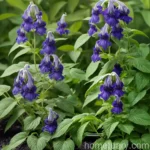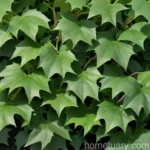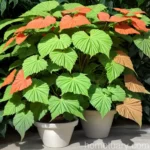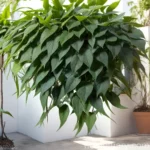The Versatile Amur Peppervine: A Comprehensive Guide to Ampelopsis Brevipedunculata
What is a Plant: Amur Peppervine (Ampelopsis Brevipedunculata)
Plants are a crucial part of the Earth’s ecosystem, playing a vital role in providing oxygen, food, and habitat for diverse forms of life. Among the multitude of plant species, the Amur peppervine, scientifically known as Ampelopsis brevipedunculata, stands out due to its versatile nature, ornamental value, and ecological significance.
This comprehensive guide aims to provide a detailed understanding of the Amur peppervine, exploring its characteristics, cultivation requirements, uses, and ecological impact. Whether you are a seasoned gardener, a landscape enthusiast, or a nature lover, this guide will offer valuable insights into the world of Ampelopsis brevipedunculata.
Key Takeaways – Amur Peppervine (Ampelopsis Brevipedunculata)
Before delving into the specifics of Amur peppervine, let’s highlight some key takeaways about this remarkable plant:
- Amur peppervine, or Ampelopsis brevipedunculata, is a versatile climbing vine known for its ornamental foliage, hardiness, and ecological benefits.
- This plant species is valued for its ease of cultivation, making it an excellent choice for both novice and experienced gardeners.
- Ampelopsis brevipedunculata exhibits a wide range of uses, including landscaping, erosion control, and as a food source for wildlife.
- While offering numerous benefits, it’s essential to be mindful of its potential invasiveness in certain regions, underscoring the importance of responsible cultivation and management.
Now, let’s delve deeper into the various aspects of Amur peppervine, from its cultural requirements to its ecological significance.
Culture
Cultivating Amur peppervine involves understanding its specific requirements for optimal growth and development. From pruning techniques to soil preferences, the culture of this plant directly impacts its overall health and vitality.
Water
Amur peppervine exhibits a moderate water requirement, preferring well-draining soil that retains moisture without becoming waterlogged. During the establishment phase, regular watering is essential to promote root development. Once established, the plant displays good drought tolerance, requiring infrequent watering, except during prolonged dry spells.
Sunlight
While Amur peppervine thrives in full sunlight, it demonstrates a remarkable ability to adapt to partial shade conditions. When grown in shade, the plant may exhibit slightly reduced vigor and foliage density compared to those in full sun. Therefore, locating it in a position that receives at least six hours of direct sunlight daily is ideal for promoting robust growth.
Fertilizer
Ampelopsis brevipedunculata is relatively modest in its fertilizer requirements, benefitting from a balanced slow-release fertilizer applied in early spring. Excessive nitrogen-rich fertilizers should be avoided, as they may promote excessive vegetative growth at the expense of flowering and fruiting. A layer of organic mulch applied around the base of the plant in spring can contribute to soil enrichment and moisture retention.
Soil
The ideal soil for Amur peppervine is well-draining and fertile, with a slightly acidic to neutral pH range. Loamy or sandy loam soils with good organic content are well-suited for promoting vigorous growth and overall plant health. Before planting, it’s advisable to amend the soil with organic matter to enhance its structure and fertility.
Pruning
Pruning plays a significant role in shaping the growth habit of Amur peppervine and managing its overall appearance. Regular pruning helps control excessive growth, maintain desired size, and promote air circulation to minimize disease incidence. Pruning is typically conducted during the dormant season, avoiding the removal of significant portions of the plant during the growing season.
Propagation
Amur peppervine can be propagated through various methods, including seed propagation, stem cuttings, and layering. Each propagation technique offers distinct advantages and considerations, allowing for flexibility in expanding plant populations.
Seed Propagation
Growing Amur peppervine from seeds involves collecting mature fruits in late summer or fall, extracting the seeds, and sowing them in a prepared seedbed. The seeds require stratification before sowing, simulating the natural cold treatment they experience during the winter. This process helps break seed dormancy, enhancing germination rates when conditions become favorable in spring.
Stem Cuttings
Propagation through stem cuttings offers a reliable method for producing genetically identical clones of the parent plant. Semi-hardwood or hardwood cuttings taken in late summer or early fall can be rooted in a well-draining propagation medium, providing the necessary warmth and humidity for successful root development.
Layering
Air layering presents another effective propagation technique for Amur peppervine, enabling the formation of roots on a stem while still attached to the parent plant. This method involves slitting a section of a healthy stem, applying a rooting hormone, and enclosing the wounded area with moistened peat moss or a similar medium. Once roots have developed, the new plant can be separated and transplanted into a suitable growing site.
Container Popularity
The adaptability of Amur peppervine extends to container cultivation, making it an attractive option for individuals with limited garden space or those seeking to enhance their outdoor living areas.
Container Common Diseases
While container-grown Amur peppervine may experience fewer disease issues compared to those grown in the ground, certain conditions can predispose them to specific ailments. Proper container drainage, soil quality, and regular maintenance are crucial for preventing common container diseases such as root rot, powdery mildew, and leaf spot.
Disease Diagnosis
Timely identification and diagnosis of diseases affecting container-grown Amur peppervine are essential for implementing effective management strategies. Symptoms such as wilting, yellowing leaves, or unusual spots should be carefully noted and investigated to determine the underlying cause. Seeking professional advice from horticulturists or plant pathologists can aid in accurate disease diagnosis and tailored treatment recommendations.
Common Pests
Amur peppervine may encounter various pests that can impact its growth and aesthetic appeal. Vigilance and proactive pest management strategies are instrumental in safeguarding the plant from pest-related damage.
Botanist’s Tips
Fun Facts
- The leaves of Amur peppervine emit a distinct peppery aroma when crushed, which adds to its allure as a sensory plant.
Links to External Resources
For further reading and exploration of Amur peppervine, the following external resources provide valuable insights and in-depth information:
- University of Florida IFAS Extension: Ampelopsis Brevipedunculata
- Missouri Botanical Garden: Ampelopsis Brevipedunculata
- Royal Horticultural Society: Ampelopsis Brevipedunculata
As a plant scientist deeply fascinated by the intricacies of plant life, Ampelopsis brevipedunculata, commonly known as Amur peppervine, serves as a compelling subject for exploration and study. Its diverse attributes, from ornamental foliage to ecological benefits, underscore the multifaceted nature of this plant species. By understanding and appreciating the nuances of Amur peppervine, we can cultivate a deeper connection with nature and further recognize the invaluable contributions of plants to our world.















